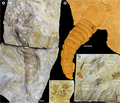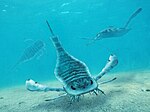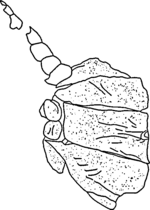This list of xiphosurans is a comprehensive listing of all genera that have ever been included in the order Xiphosura, excluding purely vernacular terms...
19 KB (608 words) - 18:02, 30 September 2024
Xiphosura (redirect from Xiphosuran)
underside of the opisthosoma. Xiphosurans move to shallow water to mate. The male climbs onto the back of the female, gripping her with his first pair of walking...
25 KB (2,275 words) - 14:26, 26 September 2024
Chasmataspidida (section Representative genera)
VI of Chasmataspis. the appendage bore exopod-like structure on the base and terminated with a chelate (pincer), similar to those of a xiphosuran. On...
31 KB (2,833 words) - 18:41, 27 July 2024
Missassigned genus Timeline of eurypterid research List of xiphosuran genera List of trilobite genera List of ammonite genera List of prehistoric malacostracans...
42 KB (1,432 words) - 03:09, 3 December 2023
cordifomnis, K. lithographicum, K. minusculum and K. walchi. List of xiphosuran genera Timeline of pterosaur research Trace fossil Mortichnia Martin, Anthony...
2 KB (167 words) - 09:52, 14 June 2023
Eurypterid (section History of study)
the Xiphosurida (the only monophyletic xiphosuran group) and other stem-genera. The internal classification of eurypterids within the Eurypterida is based...
93 KB (10,210 words) - 11:26, 7 October 2024
Jaekelopterus (category Devonian animals of Europe)
Extant xiphosurans hatch without the full complement of adult opisthosomal appendages (appendages attached to the opisthosoma, the posterior segments of the...
34 KB (3,898 words) - 21:14, 4 October 2024
2018 in arthropod paleontology (category Pages with listed invalid ISBNs)
Society of Edinburgh. 108 (1): 99–110. doi:10.1017/S1755691018000142. S2CID 135183999. E. S. Shpinev; D. V. Vasilenko (2018). "First fossil xiphosuran (Chelicerata...
177 KB (9,326 words) - 07:57, 12 October 2024
2023 in arthropod paleontology (section Xiphosurans)
developmental patterns of xiphosurans is published by Lustri et al. (2023), who find evidence of changes in the allometric growth of xiphosurans related to adaptations...
185 KB (12,022 words) - 19:29, 3 October 2024
Venustulus (category Fossils of the United States)
a group made up of various basal euchelicerate arthropods more distant to the xiphosurans. Venustulus is the third largest member of its grouping just...
12 KB (1,194 words) - 18:15, 15 July 2024
Necrogammarus (category Silurian arthropods of Europe)
of asterozoans (the group that includes starfish and brittle stars) compromising at least 16 distinct species. Other local fauna includes xiphosurans...
15 KB (1,747 words) - 21:21, 4 October 2024
Chelicerata (redirect from Reproductive systems of chelicerates)
the Xiphosurida (the only monophyletic xiphosuran group) and other stem-genera. A recent phylogenetic analysis of the chelicerates places the Xiphosura...
84 KB (8,305 words) - 05:09, 7 October 2024
Maldybulakia (category Prehistoric arthropod genera)
myriapod-like animal, and later considered related to the xiphosurans, or an artiopod. In 1992, the type species of Maldybulakia is described from the Pragian to...
8 KB (801 words) - 23:12, 18 August 2023
Borchgrevinkium (category Devonian animals of Asia)
Antarctica. He compared it with the then xiphosuran genus Weinbergina, assuming that Borchgrevinkium was also a xiphosuran. However, the Norwegian paleontologist...
17 KB (1,716 words) - 18:25, 1 September 2024
Horseshoe crab (section Genera)
Horseshoe crabs are arthropods of the family Limulidae and are the only surviving xiphosurans. Despite their name, they are not true crabs or crustaceans...
79 KB (8,016 words) - 03:18, 7 October 2024
2024 in arthropod paleontology (category CS1 maint: DOI inactive as of October 2024)
new morphological data interpret as supporting the interpretation of the Triassic genera Mirabairdia and Nodobairdia as distinct from the extant genus Triebelina...
99 KB (6,726 words) - 19:56, 16 October 2024
2005 in paleontology (section Xiphosurans)
of Lunataspis, the earliest known xiphosuran, are discovered in Canada. It was not given a formal description until 2008, however. Data courtesy of George...
57 KB (3,283 words) - 03:51, 7 August 2024
Woodward created the subclass Merostomata to contain eurypterids and xiphosurans. Ernst Haeckel classified the Merostomata (containing virtually only...
83 KB (7,524 words) - 19:23, 12 October 2024
2020 in arthropod paleontology (category Pages with listed invalid ISBNs)
distribution of this genus. A putative xiphosuran Kiaeria is reinterpreted as a member of Chasmataspidida by Lamsdell (2020a). A study on the anatomy of head...
168 KB (8,762 words) - 06:15, 12 October 2024
Willwerathia (category Prehistoric arthropod genera)
Lamsdell, James C. (2020-09-01). "A chasmataspidid affinity for the putative xiphosuran Kiaeria Størmer, 1934". PalZ. 94 (3): 449–453. doi:10.1007/s12542-019-00493-8...
9 KB (869 words) - 02:16, 26 June 2024
Cornuboniscus (category Prehistoric ray-finned fish genera)
"Xiphosurans from the Westphalian D of the Radstock Basin, Somerset Coalfield, the South Wales Coalfield and Mazon Creek, Illinois". Proceedings of the...
6 KB (525 words) - 20:34, 22 August 2024
Unionopterus (category Fossils of Kazakhstan)
(and merostomate, an outdated group that encompassed eurypterids and xiphosurans) of the entire Soviet Union after Adelophthalmus carbonarius. This specimen...
15 KB (1,677 words) - 07:24, 27 August 2024
Pruemopterus (category Eurypterids of Europe)
willwerathensis) and early xiphosurans (genus Willwerathia). Eurypterids are especially diverse in these deposits, accounting for five genera in addition to Pruemopterus:...
10 KB (1,146 words) - 10:52, 28 January 2024
Moltrasio Formation (category Geologic formations of Italy)
sediment pore waters. List of fossiliferous stratigraphic units in Italy Calcare di Sogno, Toarcian fossiliferous formation of Lombardy Saltrio Formation...
40 KB (1,866 words) - 01:32, 16 October 2024
Onychopterella (category Eurypterids of North America)
possessed four pairs of vertically oriented lamellate book gills (possibly for aquatic respiration), instead of five pairs like the xiphosuran Limulus as previously...
39 KB (4,195 words) - 12:17, 25 January 2024
Eusarcana (category Devonian arthropods of Europe)
crustaceans, xiphosurans, gastropods and anaspid fish Birkenia. In Silurian deposits of New York, E. scorpionis occurs together with a diverse fauna of eurypterids...
27 KB (2,797 words) - 17:38, 1 September 2024
Marine life (redirect from Fauna of the ocean)
estuarine strata from about 390 Ma. It was up to 2.5 m (8.2 ft) long. Xiphosurans, the group including modern Horseshoe crabs appeared around 480 Ma. Extant...
304 KB (29,025 words) - 06:15, 17 October 2024
Pterygotidae (section History of research)
well as those of other arthropods, such as crustaceans and xiphosurans; the capture and cutting of food into smaller pieces and transport of food into the...
37 KB (4,287 words) - 17:46, 7 July 2024
Adelophthalmus (category Eurypterids of Asia)
were vertically oriented. This and a fossil of the xiphosuran Tachypleus syriacus suggest that the book gills of A. pyrrhae underwent a taphonomic deformation...
94 KB (8,878 words) - 07:52, 11 December 2023
tricki, providing new information on the anatomy of this xiphosuran and representing the first record of muscles in an austrolimulid reported to date, is...
162 KB (9,468 words) - 12:16, 14 October 2024























